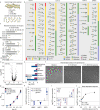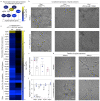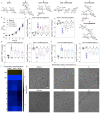Mucin O-glycans are natural inhibitors of Candida albicans pathogenicity
- PMID: 35668191
- PMCID: PMC7613833
- DOI: 10.1038/s41589-022-01035-1
Mucin O-glycans are natural inhibitors of Candida albicans pathogenicity
Abstract
Mucins are large gel-forming polymers inside the mucus barrier that inhibit the yeast-to-hyphal transition of Candida albicans, a key virulence trait of this important human fungal pathogen. However, the molecular motifs in mucins that inhibit filamentation remain unclear despite their potential for therapeutic interventions. Here, we determined that mucins display an abundance of virulence-attenuating molecules in the form of mucin O-glycans. We isolated and cataloged >100 mucin O-glycans from three major mucosal surfaces and established that they suppress filamentation and related phenotypes relevant to infection, including surface adhesion, biofilm formation and cross-kingdom competition between C. albicans and the bacterium Pseudomonas aeruginosa. Using synthetic O-glycans, we identified three structures (core 1, core 1 + fucose and core 2 + galactose) that are sufficient to inhibit filamentation with potency comparable to the complex O-glycan pool. Overall, this work identifies mucin O-glycans as host molecules with untapped therapeutic potential to manage fungal pathogens.
© 2022. The Author(s), under exclusive licence to Springer Nature America, Inc.
Conflict of interest statement
Clarissa J. Nobile is a cofounder of BioSynesis, Inc., a company developing diagnostics and therapeutics for biofilm infections. A patent application based on these results has been submitted by Massachusetts Institute of Technology and University of Basel with R.H., J.T., K.R. as inventors. All other authors declare no competing interests.
Figures











Comment in
-
Mucin modulates microbial morphogenesis.Nat Chem Biol. 2022 Jul;18(7):684-686. doi: 10.1038/s41589-022-01053-z. Nat Chem Biol. 2022. PMID: 35668190 No abstract available.
References
-
- Pappas PG, Lionakis MS, Arendrup MC, Ostrosky-Zeichner L, Kullberg BJ. Invasive candidiasis. Nat Rev Dis Primers. 2018;4:1–20. - PubMed
-
- Perlin DS. Antifungals: From Genomics to Resistance and the Development of Novel Agents. Clinical Infectious Diseases. 2015;61:1213–1214.
-
- Calderone RA, Fonzi WA. Virulence factors of Candida albicans. Trends in Microbiology. 2001;9:327–335. - PubMed
Publication types
MeSH terms
Substances
Grants and funding
LinkOut - more resources
Full Text Sources
Other Literature Sources

